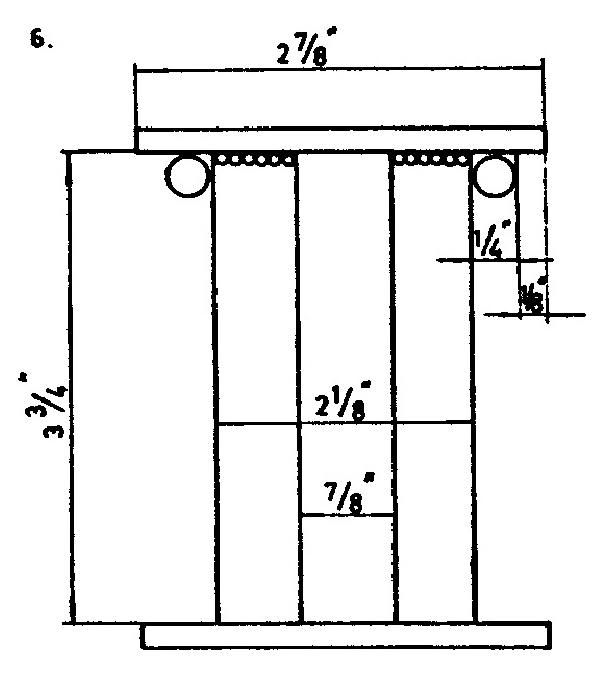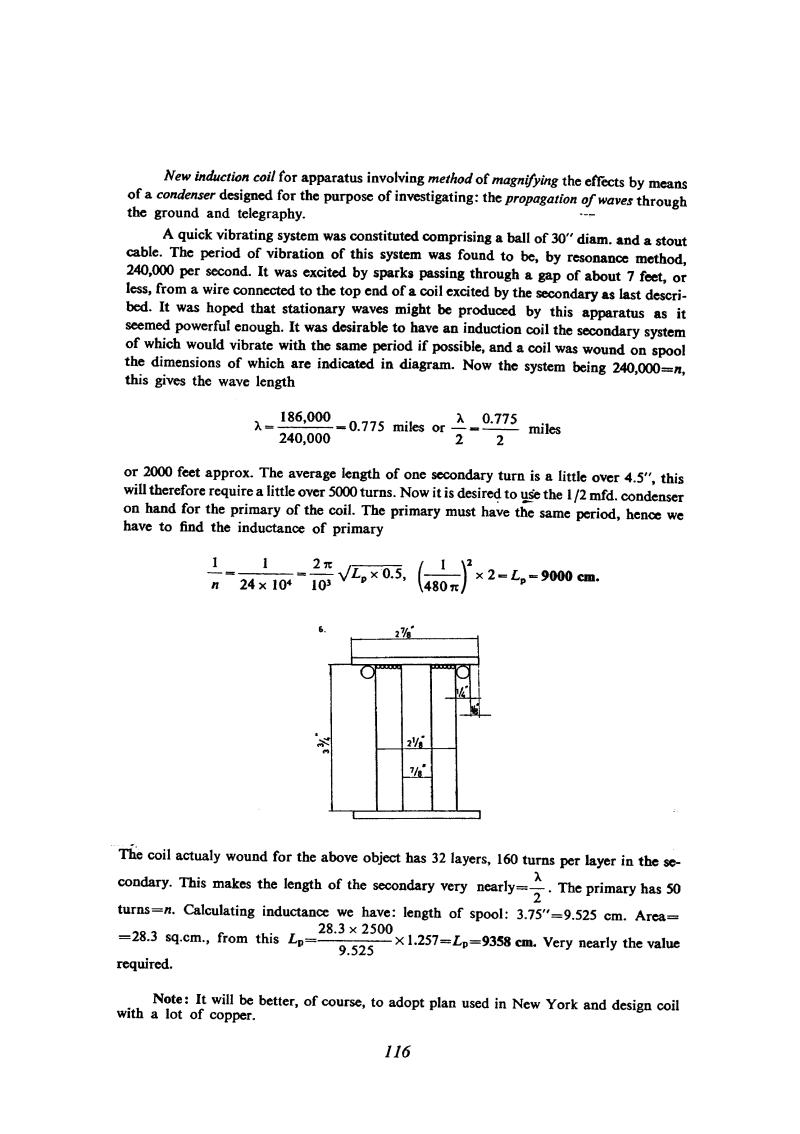
Nikola Tesla Books
New induction coil for apparatus involving method of magnifying the effects by means of a condenser designed for the purpose of investigating: the propagation of waves through the ground and telegraphy.
A quick vibrating system was constituted comprising a ball of 30" diam. and a stout cable. The period of vibration of this system was found to be, by resonance method, 240,000 per second. It was excited by sparks passing through a gap of about 7 feet, or less, from a wire connected to the top end of a coil excited by the secondary as last described. It was hoped that stationary waves might be produced by this apparatus as it seemed powerful enough. It was desirable to have an induction coil the secondary system of which would vibrate with the same period if possible, and a coil was wound on spool the dimensions of which are indicated in diagram. Now the system being 240,000=n, this gives the wave length
$! {λ = {186,000 \over 240,000} = 0.775} $! miles or $! {λ \over 2} = {0.775 \over 2} $! miles
or 2000 feet approx. The average length of one secondary turn is a little over 4.5", this will therefore require a little over 5000 turns. Now it is desired to use the 1/2 mfd. Condenser on hand for the primary of the coil. The primary must have the same period, hence we have to find the inductance of primary
$! {{1 \over n} = {1 \over {24 \times 10^{4}}} = {{2 \pi \over 10^{3}} \sqrt{L_{p} \times 0.5}, {\left(1 \over 480 \pi\right)^{2}} \times 2} = L_{p} =} $! 9000 cm.
The coil actually wound for the above object has 32 layers, 160 turns per layer in the secondary. This makes the length of the secondary very nearly = $! {λ \over 2} $!. The primary has 50 turns = n. Calculating inductance we have: length of spool: 3.75" = 9.525 cm. Area = 28.3 sq. cm., from this $! {L_{p} = {{{28.3 \times 2500} \over 9.525} \times 1.257} = L_{p} =} $! 9358 cm. Very nearly the value required.
Note: It will be better, of course, to adopt plan used in New York and design coil with a lot of copper.
116
July 30
To try and verify his hypothesis about the rejection of harmonics with appropriate coils, Tesla changed the connection of his âextra coilâ as shown in Figs. 4 and 5. To understand his way of proceeding one must take into account his ideas from 1893(6) concerning the induction of earth currents via an aerial-earth system. However, the standing waves in terms of which he tried to explain the arcing over the lightning arresters cannot be significant at these frequencies.
July 30
Along with the application of new "additional coil" Tesla repeats the experiments with his oscillator and after the usual matching procedure he achieves better results than in previous cases. He obtains sparks of approximately 2.5 meters in length. He considers the conductor curve radius influence on the current streamers appearance phenomenon. On this occasion he emphasizes the importance of current streamers elimination which create the losses and reduce the system efficiency for wireless transmission.
The conclusion on current streamers is correct, but that could not be said for the explanation of the advantage of having an elevated wire with capacitive loading in relation to the same wire without loading. In consideration of transitional events in oscillator circuits, he again separates the coil validity factor influence from the excitation influence (sudden current changes) at the instance of spark appearance and interruption in an oscillator arcing device.
Commenting on the non-existence of sparks on lightning arresters, he makes the judgment that the reasons for this are the high harmonics blocked by corresponding coils and they do not react to ground. In an effort to check his assumption, he changes "additional coil" connecting method according to Figure 4 and obtains a new oscillator configuration. Unfortunately, the experiment description is not complete, and it is not known whether he made some changes in the primary circuit in order to achieve, with connections in Fig. 3, 4, the maximum oscillator effect. The difference between connections in Figs. 4, 5 is that in the first the grounded sphere is excited via "additional coil", and in the second only the grounded sphere is excited. It is possible that the sphere system without additional coil oscillates at a higher frequency, but one cannot draw reliable conclusions without a deeper analysis.
The same day he devoted some time to design and calculation of a high frequency transformer for a high receiver. He intended to use it for operation with a "fast vibrating" system (probably as the one in Fig. 5). As far as design is concerned, the receiver was probably similar to the one of July 28.
As during many previous days, Tesla, this time as well, studies several problems. He found the time to study also the variation of voltage on supply transformer primary at various capacitive loadings. He found the voltage variation that points to the transformer impedance increase, although the secondary reactive impedance was being reduced.


